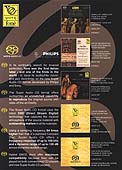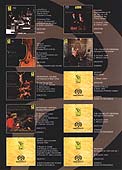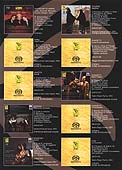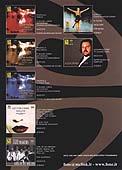Fone'Fone' e' stata la prima etichetta italiana, e tra le prime nel mondo, a pubblicare dei titoli in Super Audio CD
|
||||
|
||||
| Nella continua ricerca della perfezione musicale, FONÈ ha aggiunto il nuovo Super Audio CD, sviluppato da Philips e Sony, ai supporti discografici che ha selezionato per la sua notevole collezione di registrazioni audiophile di musica classica. Il formato Super Audio CD offre agli audiofili un'impareggiabile capacità di riprodurre la sorgente originale con una fedeltà allo stato dell'arte. Utilizza l'ultima tecnologia DSD (Direct Stream Digital) per presentare una qualità di suono superiore, con l'abilità di rendere tutte le sfumature di un suono naturale. Questa tecnologia riproduce fedelmente le forme d'onda originali, ottenendo un suono più chiaro e più naturale che cattura l'atmosfera musicale del materiale d'origine con un eccezionale realismo. Usando una frequenza di campionamento 64 volte più alta di quella di un CD, il Super Audio CD offre una risposta di frequenza fino a 100 kHz e una gamma dinamica fino a 120 dB attraverso l'intera gamma udibile, assicurando una riproduzione fedele. I dischi che sono pubblicati da FONÈ sono SACD ibridi. Questi contengono anche lo strato del CD standard, offrendo la massima compatibilità perché possono essere riprodotti sia sui convenzionali lettori CD sia sui nuovi lettori Super Audio CD. |
 |
In its continuing search for musical perfection, FONE' is the first Italian label - and one of the firsts in the world - to issue its audiophile classic and jazz recordings on the new Super Audio CD format developed by Philips and Sony. The Super Audio CD format offers audiophiles an unmatched capability to reproduce the original source with state-of-the-art fidelity. The Super Audio CD format uses the latest DSD (Direct Stream Digital) technology that captures the musical atmosphere of the source material with outstanding realism in all its nuances. Using a sampling frequency 64 times higher than that of a standard Compact Disc, Super Audio CD offers a frequency response of up to 100 kHz and a dynamic range of up to 120 dB across the entire audible range. Hybrid SACD discs offer maximum compatibility because they can be played on both conventional CD players and new Super Audio CD players. |
||
| Nell'ambito del mercato discografico classico, FONÈ propone da oltre venti anni delle incisioni realizzate all'insegna della ricercatezza tecnologica e miranti al recupero delle atmosfere musicali originali. Ogni nuova realizzazione è il risultato di un incontro appassionato tra arte dell'esecuzione ed arte dell'incisione e mira a ricreare e riprodurre lo stesso spirito con cui le opere del passato sono state eseguite. Un aspetto basilare, che fa la differenza tra FONÈ e gli altri, è la registrazione delle opere musicali in luoghi naturali e originali, costante produttiva che porta a scegliere di volta in volta lo spazio storicamente più adatto: chiesa, teatro, villa, salotto... Tutto ciò avviene recuperando una semplicità di incisione che non fa violenza alla musica: tutte le apparecchiature sono ad alta definizione. Si utilizzano coppie di microfoni a valvole Neumann degli anni 1947 e 1949 (U47, U48 e M49) dalla timbrica naturalissima usando tecniche bimicrofoniche ad effetto di campo. Questi microfoni hanno una storia importante: sono infatti i microfoni originali utilizzati per registrare le esecuzioni dei Beatles nello Studio di Abbey Road e dalla RCA per le registrazioni "Living Stereo". Non si effettua alcuna manipolazione elettronica del segnale, né alcuna artificiosa correzione, espedienti che se rendono un suono più facile da incidere, è pur vero che lo snaturano in modo inaccettabile. Con questa metodologia si arriva a trasferire le informazioni musicali sullo standard analogico (per la produzione su supporto vinile vergine 180 e 200 gr.) e sul nuovo standard digitale DSD-SACD (per la produzione su supporto Super Audio CD). FONÈ utilizza: per lo standard analogico macchine Nagra 4S e Studer C37 e J37 usate tra l'altro negli Studi di Abbey Road; per lo standard digitale, in collaborazione con Philips, processori DSD (Direct Stream Digital) ultimissimo ritrovato della tecnologia che ha aperto le porte al SACD. Per tutte le fasi successive di lavorazione e di controllo, in cui occorre un riascolto del suono, vengono utilizzati sistemi di riproduzione molto sofisticati. |
In the world of classical music recording, FONÈ has for over twenty years been using advanced techniques, aimed at re-creating the atmosphere of the original performance. Each new recording is the result of an enthusiastic encounter between the art of performance and the art of recording, and aims to reproduce the spirit with which works of the past were executed. One basic feature, which determines the difference between FONE' and other record companies, is the recording of performances in their natural spaces, that is in the places where they were originally presented. This leads to a constant search for suitable locations, and the choice of churches, theatres, country mansions, drawing rooms and so on. The recordings are carried out with the utmost simplicity, the only way not to do violence to the music: all the equipment is high fidelity; use is made of valve-type paired microphones manufactured in the years 1947 and 1949 (U47, U48 and M49) with an extremely natural and transparent timbre and a bi-microphonic field effect; these microphones have a very important history: they were used to record the Beatles at the Abbey Road Studio and by the RCA for the "Living Stereo" recordings. No use is made of electronic manipulation or artificial correction of the signal, which while making sound easier to realise also render it unacceptably unnatural. With this method, the musical information can be transferred to the analogue standard (for Lp virgin vinyl 180 and 200 gr.) and to the new digital standard DSD-SACD (for Super Audio CD). FONÈ uses for the analogue standard Nagra 4S and Studer C37 and J37 machines, used at the Abbey Road Studios; for the digital standard, in collaboration with Philips the latest DSD (Direct Stream Digital) technology, that has opened the doors to SACD. For all successive stages of elaboration and control where replay is required, highly sophisticated systems of musical recording are used. |

Fone' inizia ad interessarsi al suono Klimo nel lontano 1986 registrando nella chiesa di Santa Sabina in Roma, LUDUS DANIELIS, dramma liturgico di musica antica diretto da Frederick Renz, New York's Ensamble.
Questo impianto è chiamato Signoricci per via delle particolari modifiche tecniche apportate dalla Klimo labor alle elettroniche dell'impianto personale di Giulio Cesare Ricci, con lo scopo di ottenere prestazioni all'ascolto ancora superiori allo standard di produzione. L'impianto di riferimento di Giulio Cesare Ricci, fondatore e presidente Fone' è costantemente in funzione nella grande casa - studio. Viene utilizzato per effettuare i nuovi dischi SACD e come sistema d'ascolto di riferimento per i numerosi artisti che collaborano con lui. Avendo realizzato per vent'anni il master analogico contestualmente a quello digitale, in occasione di ogni registrazione, a partire dal 2004 Giulio Cesare Ricci ha deciso di offrire al pubblico degli analogisti la 4a generazione di vinile Fone'. Le anteprime viniliche saranno dimostrate con il sistema Klimo Signoricci in specifiche sedute d'ascolto. Gli illustri ospiti interessati all'ascolto analogico e digitale del sistema Signoricci possono ricevere maggiori informazioni compilando la |
Fone''s interest in Klimo sound bornt in 1986, recording in Santa Sabina church in Rome, Ludus Danielis, ancient music liturgic drama, conducted by Frederich Renz, New York's Ensamble. On that occasion, Fone' used as amplification unit to monitor the recording, a Klimo Merlin preamplifier with a pair of Klimo OTL final amplifiers. Today, at a distance of 20 years since that wonderful recording, Fone' finds once again the maximum of hi-end reproduction in the Klimo sound, for resolution, dynamic and detail. After several test sessions of hi-end chains, without expenses limitation, Fone' states without mince matters, that one of the most charming and spectacular stereo and multichannel SACD reproduction, is the one got with Klimo's tubes amplifications. Later on, Fone' sets up with Klimo Labor team support a multichannel sistem really special... Signoricci hi-end system:
This system is called Signoricci for the special technical modifications made by Klimo Labor's team to amplification units of the Giulio Cesare Ricci's private hi-end system , to reach greater listening performances respect the standard ones. The reference Giulio Cesare Ricci's personal hi-end system , founder and president of Fone', plays constanctly in his big house-study, both for recording new SACD and as audio reference system for the large number of artists who cooperate with him. And as for over twenty years, Fone' has been ever realizing the analogic master, in addition to the digital one, for every reproduction, he decided to offer by the 2004, to the analogist music lovers the fourth generation of vinilic edition by Fone'. The vinilic previews will be presented with the Signoricci Klimo's system during specific audio sessions. The illustros guests, interested in the analogue and digital audio session of the Signoricci system, can reach more information, filling the |

 |
per l'intero catalogo visitate: for complete catalogue visit: www.fone.it |
||
 |
 |
 |
 |
Il mio sogno è sempre stato quello di incidere il suono del silenzio e nel silenzio trovare il respiro della vita. Giulio Cesare Ricci |
My dream has always been to record the sound of silence, and in silence to find the breath of life. To record the feelings and the emotions of people, as nearly as I can. Giulio Cesare Ricci |
||
 La storia
La storia Performance Line
Performance Line Giradischi
Giradischi Finali
Finali Diffusori
Diffusori Componenti speciali
Componenti speciali Cavi
Cavi Discografia
Discografia Recensioni
Recensioni Usato Garantito
Usato Garantito Dati Tecnici
Dati Tecnici

 suonoecomunicazione.com
suonoecomunicazione.com